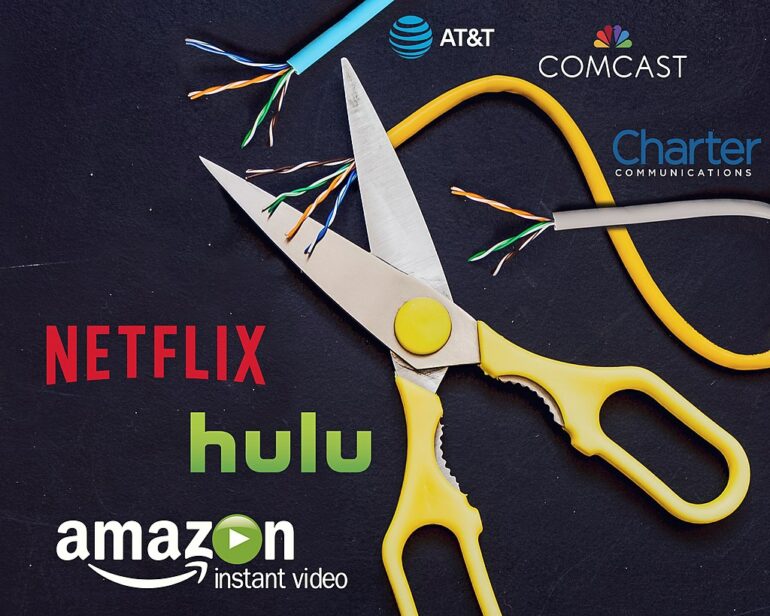Americans are changing how they watch shows, and it’s having a dramatic impact on the future of entertainment. For the first in history, US adults spent more time streaming digital video on platforms such as Netflix, TikTok and YouTube than they did watching traditional television.
Yahoo reported, “In the historic first, the market tracker expects “linear TV” to account for less than half of daily viewing, dropping to under three hours while average daily digital video watching climbs to 52.3 percent with 3 hours and 11 minutes.
‘This milestone is driven by people spending more and more time watching video on their biggest and smallest screens, whether it’s an immersive drama on a connected TV or a viral clip on a smartphone,’ Insider Intelligence principal analyst Paul Verna said in a release.
‘Given teens’ preferences for social and streaming video over TV, we can expect these trends to continue to shift in favor of digital.’
Netflix and YouTube are ‘neck and neck’ leaders when it comes to digital video audience attention, with US adults tuning in for about 33 minutes daily on average at each platform, according to Insider Intelligence.
The industry has scrambled to catch up to its online competition. The Hollywood Reporter wrote, “The past five years has seen every major Hollywood giant lean into streaming entertainment, pulling programming budgets from broadcast and cable channels and funneling them into wholly owned streaming services. But there also have been exceptions: sports and news, which TV executives have long argued hold the legacy pay TV bundle together. Warner Bros. Discovery CEO David Zaslav, for example, told Wall Street analysts this past summer that linear TV is “a cash generator and a great business for us for many years to come.”
But even live coverage of events, including sports, may no longer be saving cable television.
THR continued: And in the sports world, executives are beginning to grapple with the rocketing cost of sports rights, with similar implications. ESPN “is going through some obviously challenging times because of what’s happened in linear programming,’ Disney CEO Bob Iger told analysts Feb. 8. While Iger said he wants ESPN to stay in business with the NBA (the next major league with rights renewals coming up), he added that the menu of promising sports deals is likely to slim down. “I’ve had long conversations about this with [ESPN chief] Jimmy Pitaro, and we’ve got some decisions that we have to make coming up,” Iger said. “And we’re simply going to have to get more selective.”
Zaslav has also signaled that Turner Sports, which has NBA, MLB, NHL and March Madness rights, will reevaluate its portfolio. While the NBA has been a staple of TNT’s lineup since 1989, Zaslav told analysts Nov. 3, ‘We don’t have to have the NBA.” He added that while he would like to cut a new deal, it would need to be ‘a deal for the future, it can’t be a deal for the past.’
It all makes for a perfect storm. Sports and news have been the safest bets in linear TV, and suddenly they don’t look so safe anymore. With companies now pivoting streaming services to focus on profitability, the fate of linear TV is even more uncertain, as the desire to salvage that cash flow grows. The linear business is ‘in crisis,’ Naveen Sarma, senior director at S&P Global, wrote in a late January report: ‘What the networks [with sports] get in topline support they give up in higher programming costs that are likely to grow even as revenues come under greater pressure. Conversely, linear TV networks without sports are increasingly experiencing weaker advertising and affiliate fee revenues but have a greater ability to control programming costs.’”
While sports viewership may be peaking overall, Americans still love their football. This year’s Super Bowl between the Philadelphia Eagles and Kansas City Chiefs “averaged 113 million viewers across Fox’s television and digital properties, according to early data from Nielsen,” wrote CNN.
“That makes Super Bowl LVII the third most-watched television program of all-time. And it represents the best audience for the big game in six years, topping 2022’s showdown, which averaged 112.3 million viewers on NBC.
Fox Sports said that the Apple Music Halftime Show featuring Rihanna drew an average of 118.7 million viewers, making it the second most-watched performance in Super Bowl history.
That said, it is worth noting that the decline of linear is present in the viewership data. Fox said Super Bowl LVII was the most-streamed Super Bowl in history, with an average of 7 million people watching via internet-based services. That figure represents an 18% jump from last year.”
[Read More: Americans Spend Less Time On Vacation Than They Did Decades Ago]



